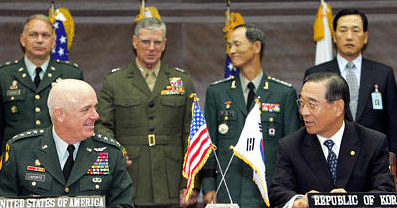Korea wants more autonomy while the U.S. seeks a flexible Asian strategy.

On Oct. 26, 2004, Leon LaPorte, left, commander of U.S. Forces Korea, with South Korea’s Defense Minister Yoon Kwang-ung, right, after signing agreements to relocate Yongsan Garrison and to hand over other U.S. bases to the South Korean government at South Korea’s defense ministry office in Seoul. [YONHAP]
South Korea’s alliance with the United States has been largely asymmetrical. The Korean War threw the country by default onto the U.S. side at a time when it was drawing as many states as possible into its orbit during the Cold War in an effort to fight communism.
In the past, such an alliance was feasible due to South Korea’s relatively low standing in the world order. However, its circumstances have changed as the country has risen from the ashes of war to forge an economy that has become a crucial piston in today’s global economic engine.
Even the average citizen who does not have much time to think of world affairs, may have heard about the debate going on in Seoul as the Roh administration has sought to establish a louder voice in the alliance with the United States. Much of this effort, apart from economic ties, has focused on security arrangements, which have been the centerpiece of the alliance.
Since U.S. forces were stationed on the Korean peninsula, there have been four reductions in its troop strength here. The last one was initiated in 2004 when the two sides agreed to reduce the number of U.S. soldiers by 12,500 phased over time, bringing down the total to 25,000 by 2008. In addition, over the past couple of years, Seoul has taken over the bulk of 10 major military missions that were previously conducted by U.S. forces, such as coordinating counter-firing missions against possible North Korean artillery attacks.
In January of last year, Washington and Seoul also agreed on the “strategic flexibility” of U.S. forces stationed on the Korean peninsula, opening the way for Washington to use its troops here for military missions elsewhere. One such mission would include a conflict in the Taiwan Straits, although the agreement did not spell out the details.
Seoul has taken the initiative for recent changes in the alliance by demanding the transfer of wartime operational control of South Korean troops. Both sides agreed last year that the transfer would take place after Oct. 15, 2009 but not later than March 15, 2012. President Roh has linked the issue with national pride; he has argued that the South Korean forces have grown strong enough to shoulder a heavier burden for the nation’s defense. With a change in the joint security measures with the United States, Seoul is also on course to create a smaller but more efficient military as it plans to reduce its troop level from the current 680,000 to 500,000 by 2020 and to acquire more high-tech weaponry to make up for the reduction in manpower.
Coupled with the idea of a more self-reliant defense, the administration’s engagement policy toward the North has helped bring about a fundamental change in the alliance. Rooted in former President Kim Dae-jung’s Sunshine Policy, Seoul has taken on the peace-through-rapprochement approach. It reasons that constant engagement with the North will eventually lead to a fundamental change of the North’s society for the better.
Engagement will also prevent sudden collapse since the North’s economy is being rebuilt with help from the South and the international community.
That approach does not exactly correspond with Washington’s view, which considers North Korea a “rogue state” that could readily sell its nuclear stockpile to terrorists. American leaders believe the North needs to be isolated and punished if it becomes a security risk to the United States.
Recent developments have clearly shown that the alliance is in transition. This has been confirmed by Ban Ki-moon, the former foreign minister (and now the secretary-general of the United Nations) who summed up the state of the alliance well when he said in August last year that bilateral ties were undergoing some “readjustment.” He suggested that Washington may be disgruntled because Seoul has been asserting itself in ways it hasn’t done in the past.
Issues raised by past troop pull-outs, the “strategic flexibility” of U.S. troops here and Seoul’s own demands for a greater say in the alliance have changed the nature of the relationship. Of late, each side has tried to be flexible in how shared responsibilities are fulfilled amid changing dynamics in the region. The U.S. is eyeing the strategic value of South Korea in a region it believes a counterbalance is needed for a rising China. South Korea is trying to maintain the alliance even as it pursues reconciliation with the North.
President Roh Moo-hyun has succeeded in setting the wheels in motion but there has been some concern in Washington about whether Seoul has a long-term plan in place. General Burwell B. Bell, the commander of U.S. Forces Korea, underlined that concern in September last year when he asked, “In exercising independent operational command and in developing future alliance war plans, what will be the ROK government’s strategic war aims, military objectives and desired war-end state?”
Furthermore, the general wanted to know, “In exercising independent command, how will the ROK government manage the armistice and exercise crisis management in any future confrontation with North Korea?”
As demonstrated in past years, the future of the alliance will be shaped to a large extent by inter-Korean interaction and how Washington views South Korea’s strategic value in its overall plan to maintain influence in the region while countering China’s increasing influence. The way the North Korean nuclear crisis is solved will also alter the future shape of the alliance.
By Brian Lee Staff Writer africanu@joongang.co.kr










with the Korea JoongAng Daily
To write comments, please log in to one of the accounts.
Standards Board Policy (0/250자)